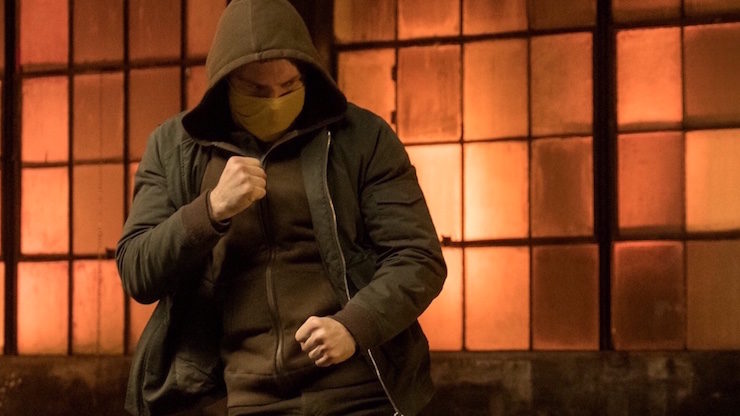A major complaint about Marvel’s Iron Fist season one (from me and others) was its weak-kneed portrayal of hand-to-hand combat and martial arts. This was a problem on several levels. One, the lead actor had no experience with martial arts or choreographed fighting. Two, the fight choreography was dismally bad. And three, that first season showed absolutely no understanding of kung fu in particular and martial arts in general.
The second season improved on some of these issues, but not quite enough of them. And in trying to fix one problem, they introduced more.
SPOILERS for Iron Fist season two, as well as the other MCU Netflix shows.
Getting the obvious out of the way, you gotta wonder what they were thinking (a) casting somebody with no martial arts experience to play the character who has been known in the comics since 1973 as “the Living Weapon,” the best martial artist in the Marvel Universe and (b) not getting a decent fight choreographer. It’s not like such options don’t exist. Hell, we see a whole bunch of people who are better at choreographed combat on Into the Badlands. Not all of them are trained, but they have superlative fight choreography—hell, they managed to make oval-shaped Nick Frost into a more convincing fighter than Scott Buck and the gang managed with Finn Jones in Iron Fist season one. It’s really kind of sad when you’ve got five characters with their own series, and the one with by far the worst fight choreography is the one about the martial artist.
This would be forgivable if Jones brought some kind of ineffable quality to the role, but he really doesn’t. He’s arguably the worst protagonist in Marvel’s pantheon since the debut of the Marvel Cinematic Universe a decade ago with Iron Man. (The only main character who comes close to being as awful is Anson Mount’s grimacing turn as Black Bolt in Inhumans.)
It’s not entirely his fault, of course, because of that third issue.
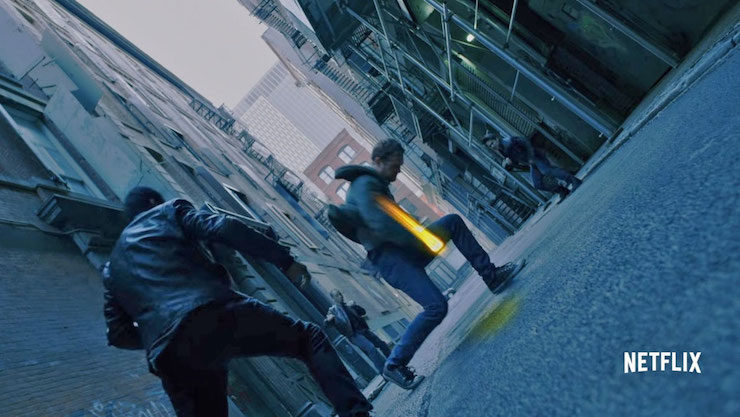
K’un-Lun, in both the comics and the TV show, is a place of pure martial artistry. The people of K’un-Lun are trained in combat from the moment they can walk (if not sooner). Martial arts—and in the TV series, they specify that it’s kung fu they’re training in—is a way of life there in a manner that is purer and more focused than it would be outside K’un-Lun’s walls, as the compromises of being part of the greater world don’t exist there. It’s a city enshrouded in dimensional mists that only intersect with our world once every fifteen years (ten years in the comics, but whatever).
The thing is, someone raised in that world should be the ideal martial artist. One who is focused and serene. One who only uses violence as a last resort, and who tries to minimize the damage done to one’s opponent. One who knows that once a fight has started, it has already been lost.
Of course, not every student is the same. Some take to the lessons better than others. But the ones who don’t take to it particularly well don’t ascend to the highest calling in the city, to wit, to become the Iron Fist.
Danny Rand is supposed to be the finest fighter in all K’un-Lun. He is supposed to have absorbed the lessons of kung fu, of martial arts, of being the Living Weapon better than anyone. He is supposed to be able to defeat any opponent, which is why he was given the honor of fighting Shao Lao the Undying to become the Immortal Iron Fist.
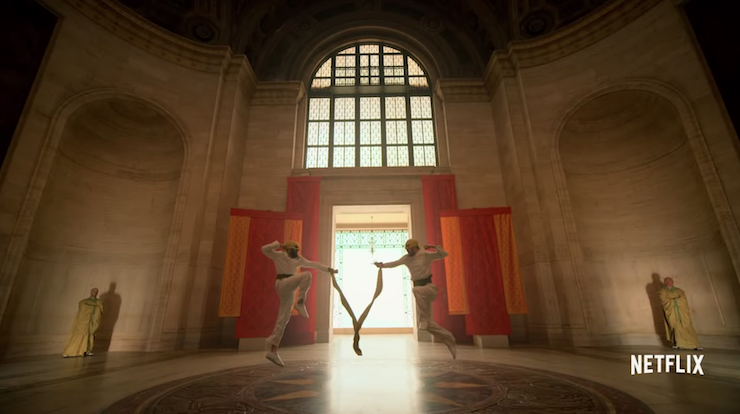
The one thing he should never, ever, ever be portrayed as is a whiny entitled twerp. And it’s not like this is arcane knowledge that only a martial artist would understand, because all Buck and his team of writers had to do to see what a good portrayal of someone from such a city trying to survive in modern New York would be is to read the comic books their TV show is based on.
Upon taking over from Buck, one of the things M. Raven Metzner did was address these problems. Jones is what he is at this point—his ability to do choreographed fighting is better in season two of Iron Fist than it was in The Defenders season one, which in turn was better than it was in Iron Fist season one, so there’s that. But “better” isn’t “good.” He’s still the third-best martial artist in the opening credits, behind Jessica Henwick—who learned wushu in preparation for her role in Spirit Warriors—and Sacha Dhawan—a trained dancer (the Venn diagram of choreographed hand-to-hand combat and a dance has significant overlap). Season two conveniently filmed during winter in New York City, so they didn’t even need to contrive an excuse for Rand to go out on patrol in Chinatown wearing a hoodie that conveniently obscured his face so the stunt double could be swapped in.
In addition, the position of fight choreography was upgraded, as Clayton Barber was brought over from Black Panther to handle the fight scenes, and the improvement is noticeable. Of course, it’s more noticeable when someone other than Jones is involved, but you do what you can. To be fair, one of the best scenes is Davos and Rand’s fight in K’un-Lun for the right to go for the iron fist. (The best is Colleen Wing and Misty Knight’s fight against the Crane Sisters.)
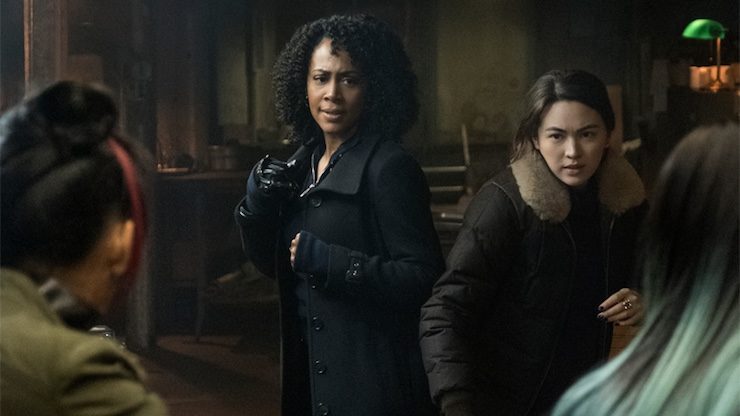
The major change, though, is seen when Rand details the feelings he has inside him, the heart of the dragon that powers the iron fist that pushes at the back of his mind, urging him toward chaos.
Now, we have a reason why someone who was raised in a society where kung fu is a lifestyle has been acting like such a douchenozzle. It’s the iron fist that fights against the serenity of martial arts. To emphasize the point, Rand is much more calm and centered after he loses the fist to Davos, while Davos—already unhinged by the loss of K’un-Lun—starts to crumble under the weight of the crazy.
Davos was actually a reasonable person in season one—pissed off, certainly, though that was justified by his own lights. But he’s also suffered trauma of his own, losing the iron fist, losing his best friend, and losing his home—and also his purpose. He thinks he deserves the iron fist, and it’s telling that one of the two things he does once he obtains it is try to make his own little K’un-Lun, as that’s all he knows. So he recruits a bunch of kids and starts training them. Though we only see the violence, we don’t see the philosophy, the wisdom, the serenity, the focus—we just see punching and kicking, which is not all there is to martial arts. We can forgive this to some degree, as Davos is broken even before he gets the iron fist, and after he achieves it, he goes seriously all binky-bonkers (particularly evidenced by his murder of the innocent restaurant owner).
This is handy as a retcon, but it doesn’t really make sense.
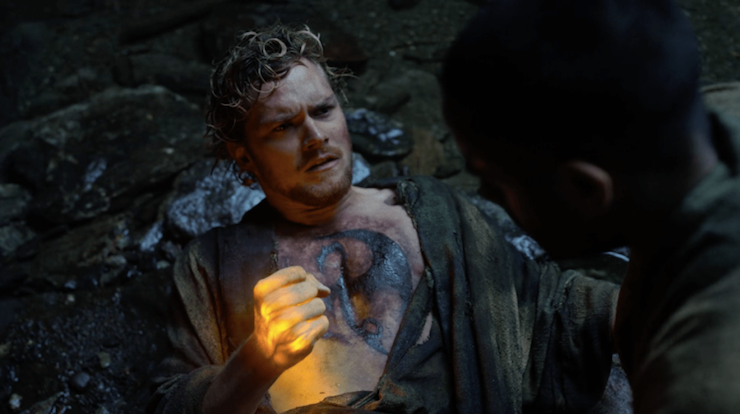
For starters, dragons in Asian myths are benevolent and powerful—it’s European dragon legends that talk of fire and destruction. In addition, while there are martial arts, and martial arts teachers, out there that are chaotic and violent and mostly in it for the opportunity to be a badass fighter, the vast majority of Asian martial arts in particular are geared toward focus, toward being centered, toward serenity. The purity of the movements of forms, being able to lose yourself in technique, the boiling away of frustrations and irrelevancies through the effort of accomplishing those techniques, and most of all the awareness of your own self (both mentally and physically) that you must have in order to master the styles. One of the best ways for me to deal with stress and frustration is to go to the dojo and sweat it out, as it were. In particular I’ve found that kata—prearranged forms—are very good for clearing my mind.
And I only do karate a couple three times a week or so, I didn’t grow up with it from the age of ten with nothing else significant in my life. Rand had no other distractions growing up. Everything was geared toward living the life of a master martial artist, an ascetic, aesthetic lifestyle that would result in someone who had achieved serenity.
But the Danny Rand we see on Netflix has nothing resembling serenity, and he spends season two seeking it out. (This puts him in company with the rest of the cast, as Wing, Knight, and both Meachams are searching for that same serenity in the wake of trauma.) And I gotta ask, why?
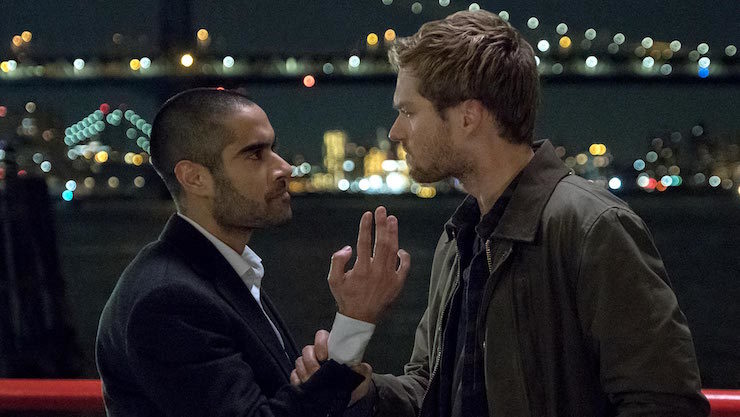
If it is the iron fist, then that raises another question: why would a city dedicated to the mastery of kung fu have as its highest aspiration be to become the Immortal Iron Fist, if the fist makes you crazy? If it negates all the training you went through to get it—worse, it negates the very philosophy under which your isolated city is supposed to be living under—why is it so aspirational? And also, if you need a protector for your city full of martial artists who’ve been trained since birth, why not use all the martial artists who’ve been trained since birth instead of just one dude with a glowy fist? Especially if that one dude is going to become unstable and twerpy when he gets the fist?
Some of these questions could be answered if we actually spent any significant time in K’un-Lun. (Just as a for-instance, maybe the dragon needs to be tamed, and the winner of the contest has to make the sacrifice of losing their focus and serenity in order to keep the dragon tamped down. Though, again, that really only tracks with European dragon legends, not Asian ones, but it’s a thought.) The first season showed us virtually nothing of the ancient city, and while the second season did better in that regard, it was mostly for the purposes of illuminating Davos’s character. As it is now, it serves only to put a band-aid on a bullet wound, and is about as effective. It answers one question, but raises several more. It’s maddening, because K’un-Lun is such an important part of Rand’s backstory (his first appearance in Marvel Premiere #15 took place entirely in K’un-Lun), and its lack has been a continued source of frustration.
Not that I blame Metzner for trying to fix it. We’re stuck with Douchenozzle Danny as Iron Fist (or, at least, as Danny Rand, since the fist hops from him to Davos to Wing), so he’s just trying to make the best of it. And there are actually story possibilities to be mined from the questions I’ve been asking here. Maybe season three will handle it…
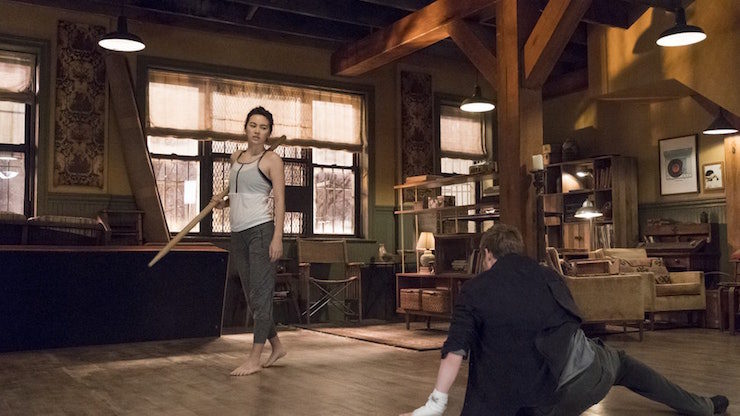
I want to end on a more positive note, so I will mention that one aspect that does ring right is the approach to teaching. The highest aspiration of a person who trains in the martial arts is to become a teacher—even styles that focus on fighting tend to have teaching as the ultimate aspiration, as the aging process tends to eventually erode one’s fighting skills. We see that with both Davos and Wing. In the former’s case, becoming a teacher is as important to him as doing Rand’s job as Iron Fist better than him. Training, passing on the traditions—those lessons are still critical.
As for Wing, her journey is nastier, as the whole notion of teaching has been tainted for her. When we first saw her, she ran a dojo, but it was a Hand front. Bakuto corrupted the teaching process for her by making it a method of recruiting soldiers. With Bakuto dead and the Hand destroyed, she has found she can no longer teach in good conscience. But not permanently: for one thing, we know from Luke Cage season two that she worked with Knight on getting her groove back after losing her arm. Here, she has to be convinced by Rand to re-train him how to fight without the iron fist (which is another example of how corrupting the iron fist must be, if he needs that much re-training after losing it, given the fifteen years of training that came before he faced Shao Lao). It takes a lot to get her to take up that mantle again, and ultimately it proves to be her salvation. Bakuto’s destruction of teaching has been replaced with a better, more beneficial experience. She can be the teacher she always should have been.
It’s frustrating that the best use of Asian philosophy and understanding of martial arts with regard to the Rand character came, not from any of the three series Finn Jones starred in, but in the one in which he was a special guest star: “The Main Ingredient,” the tenth episode of Luke Cage’s sophomore season. We need more of that Iron Fist, and less of the whiny twerp.
At the very least, Metzner was able to make a silk purse—or, at the very least, a nice linen purse—out of the sow’s ear that was season one of Iron Fist. We’ll see if whoever show-runs season three will take cues from that episode as well as all the work that was done in season two. It’s not there yet, but progress has been made.
Keith R.A. DeCandido is a third-degree black belt in karate. He trains regularly, and also teaches several classes a week to kids, including a couple of afterschool programs here in New York City. He’s been writing about pop culture for Tor.com since 2011. He is currently running a Kickstarter for a short story set in the same universe as his Dragon Precinct fantasy series.










